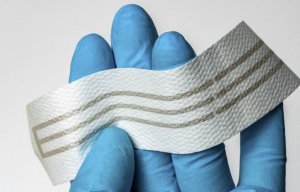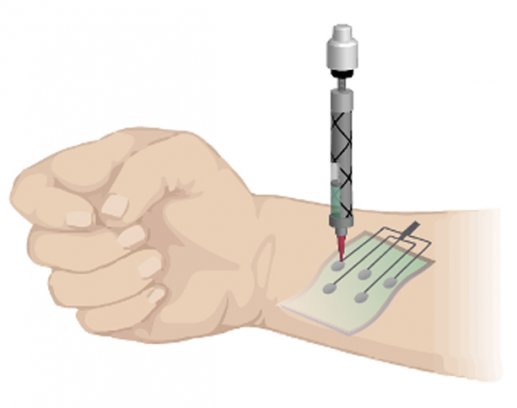
Saral StretchSilver 500 ideal for wearables
Structures are extremely elastomeric and can be compressed, bent or twisted without breaking.

24th August 2022
Innovation in Textiles
|
Texas, USA
Researchers at Texas A&M University has developed a new class of biomaterial inks that mimic native characteristics of highly conductive human tissue, much like skin, which are essential for the ink to be used in 3D printing.
Flexible electronics have enabled the design of sensors, actuators, microfluidics and electronics on flexible, conformal and/or stretchable sublayers for wearable, implantable or ingestible applications. These devices, however, have very different mechanical and biological properties when compared to human tissue and thus cannot be integrated with the human body.
The new biomaterial ink leverages a new class of 2D nanomaterials known as molybdenum disulfide (MoS2). The thin-layered structure of MoS2 contains defect centres to make it chemically active and can be combined with modified gelatin to obtain a flexible hydrogel.
“The impact of this work is far-reaching in 3D printing,” said Akhilesh Gaharwar, associate professor at the university’s Department of Biomedical Engineering. “This newly designed hydrogel ink is highly biocompatible and electrically conductive, paving the way for the next generation of wearable and implantable bioelectronics.”
The ink has shear-thinning properties that decrease in viscosity as force increases, so it is solid inside the tube but flows more like a liquid when squeezed, similar to ketchup or toothpaste. The team incorporated these electrically conductive nanomaterials within a modified gelatin to make a hydrogel ink with characteristics that are essential for designing ink that can be 3D printed.
“These 3D-printed structures are extremely elastomeric and can be compressed, bent or twisted without breaking,” said Kaivalya Deo, graduate student in the biomedical engineering department. “In addition, they are electronically active, enabling them to monitor dynamic human motion and paving the way for continuous motion monitoring.”
In order to 3D print the ink, researchers in the Gaharwar Laboratory designed a cost-effective, open-source, multi-head 3D bioprinter that is fully functional and customisable, running on open-source tools and freeware. This also allows any researcher to build 3D bioprinters tailored to fit their own research needs.
The electrically conductive 3D-printed hydrogel ink can create complex 3D circuits and is not limited to planar designs, allowing researchers to make customisable bioelectronics tailored to patient-specific requirements.
In utilising the 3D printer, Deo was able to print electrically active and stretchable electronic devices which demonstrate extraordinary strain-sensing capabilities and can be used for engineering customisable monitoring systems. This also opens up new possibilities for designing stretchable sensors with integrated microelectronic components.
One of the potential applications of the new ink is in 3D printing electronic tattoos for patients with Parkinson’s disease. Researchers envisage that the printed e-tattoo could monitor a patient’s movement, including tremors.

Business intelligence for the fibre, textiles and apparel industries: technologies, innovations, markets, investments, trade policy, sourcing, strategy...
Find out more